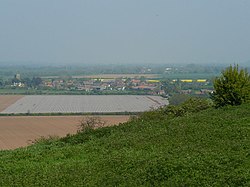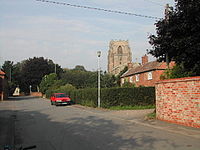Shelford, Nottinghamshire
| Shelford | |
| Nottinghamshire | |
|---|---|
 View of Shelford, taken from Gibbet Hill | |
| Location | |
| Data | |
| Population: | 673 (2011, with Newton) |
| Post town: | Nottingham |
| Postcode: | NG12 |
| Local Government | |
| Council: | Rushcliffe |
| Parliamentary constituency: |
Rushcliffe |
Shelford is a village in Nottinghamshire, near Radcliffe on Trent. It has an old manor house (built on the site of Shelford Priory), a church and a Caravan Park and Bar. It also has a pub restaurant, The Earl of Chesterfield Arms.
The village stands on the floor of the Trent Valley, Shelford is protected from flooding by comprehensive flood protection. This renders the probability of flooding very low. Even in the floods of 2000 the rising waters did not impinge upon the housing in the village.
The village had a ferry which ran between Shelford and Stoke Bardolph, but this has long since disappeared. The wooden structure tethering the rope for pulling the ferry can still be seen today at the end of Stoke Ferry Lane.
Name
Shelford contains the Old English word scelde for shallowness; perhaps indicating then a shallow ford.[1][2]
Parish church
The parish church is St Peter and St Paul's Church. It is a Grade II* listed building.[3]
The church is of medieval style and era but was heavily restored between 1876 and 1878 by Ewan Christian.[4] The tower of the church was used by then Royalists during the siege of Shelford Manor during the Civil War.
There is stained glass in the chancel by Charles Eamer Kempe and in the north aisle by Alexander Gascoyne.
An early clock was installed in 1680 by Richard Roe.[5] This was replaced in 1880 by a new clock mechanism by G. & F. Cope of Nottingham.
History

In this village stood Shelford Priory, a former Augustinian house founded by Ralph Haunselyn around 1160–80. It was dissolved in 1536.
The village was the scene of a battle in the Civil War, when the Royalist garrison of Shelford Manor was taken on 3 November 1645.[6] A re-enactment of this battle takes place periodically by the Sealed Knot, a civil war re-enactment society. Held over a weekend, the activities centre upon West and Church Streets, the church and finally the manor house.
Events
- A feast weekend is held every second year, which features a street market, events and other activities, centred on the church and village hall. Over the weekend some houses open their gardens for a small donation to charity, giving visitors the opportunity to stroll through impressive rural gardens in a pretty village setting.
| ("Wikimedia Commons" has material about Shelford, Nottinghamshire) |
References
- ↑ Gover, J. E. B.; Mawer, A. & Stenton, F.M.: 'Place-Names of Nottinghamshire , Part' (English Place-Names Society, 1940), page 241
- ↑ Ekwall, Eilert, The Concise Oxford Dictionary of English Place-Names. Oxford, Oxford University Press, 4th edition, 1960. p. 415 ISBN 0198691033
- ↑ National Heritage List 1250021: Church of St Peter and St Paul (Grade II* listing)
- ↑ Nikolaus Pevsner: The Buildings of England: Nottinghamshire, 1951; 1979 Penguin Books ISBN 978-0-300-09636-1page 156
- ↑ Beeson, C.F.C. English Church Clocks 1280-1850. Brant Wright Associates Ltd. ISBN 0903512149.
- ↑ C. Brown, A History of Nottinghamshire (1896), pp.77-9
